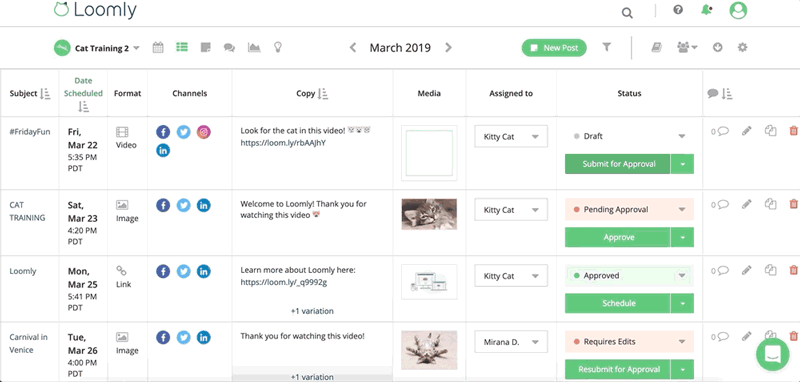7 Things That Kill Your Marketing Team Productivity (And What To Do About It)
As a brand, we all want to maximize our marketing team productivity.
The more efficiently we can work the more people we are able to reach.
But we often take the wrong approach to increasing productivity.
We look at the tips and tricks and hacks we can add that will help us eke a little extra work out of each moment.
But we often neglect the deep-seated problems that kill our marketing team productivity in the first place.
There are interruptions and distractions and pressures that, if we can fix them, will unleash a level of productivity our marketing teams never thought possible.
In this guide, we are going to show you the seven things that kill your marketing team productivity, so you can effectively identify and solve the problems.

Manage all your social media accounts in one place.
Craft, schedule, & auto-post content to all your social channels, then track analytics and manage interactions from a single, easy-to-use dashboard.
1. Mobile Phones
Let’s face it:
Most of us are hooked to our mobile phones.
We love the dopamine hit we get when we check our phone and see texts, likes, and notifications.

Although mobile phones can have a positive impact on the workplace when used correctly, their misuse can also be detrimental to your marketing team productivity.
The average worker spends 59 working minutes a day using their phone for non-work related activity. That’s five hours a week!
There’s also a lot to be said for how constantly checking a mobile phone can reduce your ability to get into the zone or your flow state. Why?
Because — as this survey from Front shows — the average worker is interrupted by notifications around 10 times per day. That’s a lot of interruptions which can take you around 25 minutes to recover from.
But there is also some research to suggest that high mobile phone usage, or having a mobile phone present, can prevent people from entering a state of flow. It has also been shown to decrease performance on academic and cognitive tasks.
This is why many CEOs, like Mathilde Collin, have quit notifications. Although there was plenty of FOMO and anxiety at the start, the end result was calm productivity she and her team had rarely experienced in the past.
Basically, there are few positive outcomes from checking your mobile phone — at least for personal use — when you’re trying to focus on a task.
“If you don’t pay appropriate attention to what has your attention, it will take more of your attention than it deserves.”
— David Allen
2. Seagull Management
Seagull managers are those who usually have little to do with their teams, but abruptly swoop in when they see a problem.
They do this in such a negative way that they leave nothing but confusion and stress in their wake.

Although there is nothing wrong with a manager highlighting a problem, the issues here comes with how the situation is handled and its impact on the marketing team.
Morale and productivity are driven by the team’s leaders. This is often the manager or the supervisor.
If all a manager does is share negativity and problems, without the balance of praise and positive feedback, it is going to impact their marketing team productivity and even cause collaborators to leave negatively.
3. Inefficient Workflows
Inefficient marketing workflows — especially those focused on content creation — can really slow down your marketing team productivity.
We all know what it is like to have a deadline you need to meet, but your progress is halted because you are waiting on someone’s response or approval to go ahead.
Having constant bottlenecks and tight deadlines can:
- Increase errors.
- Slow output.
- Cost money.
Meaning you’re left with an end product you know is a world away from what your marketing team is truly capable of.
At Loomly, we know the importance of efficiency in the marketing department, which is why we have created a tool that seamlessly allows different people and departments to work together:

You can learn more about how to create efficient social media workflows and boost your marketing team productivity.
“Nothing is less productive than to make more efficient what should not be done at all.”
— Peter Drucker
4. Meetings
Meetings: (to be pronounced à la John Oliver).
They are a necessary evil in the business world. And, for a good reason.
For collaboration, creativity, and collective input, there is no better solution than getting people around a table for a productive discussion.
But the problem with meetings hangs on that word, “productive”.
The truth is, many of the daily meetings we attend are the exact opposite.
Take a look at this survey from the Harvard Business Review. When they asked 182 senior managers for their views on meetings, they received some worrying responses:
- 65% said meetings kept them from completing their work.
- 71% said meetings are unproductive and inefficient.
- 64% said meetings come at the expense of deep thinking.
This means when a meeting feels like it is just for the sake of it, it can have a deep impact on your marketing team productivity.
Marketing is a creative pursuit. This means there is a need to get people together to brainstorm, share ideas and come up with innovate solutions.
But creativity also comes from spending focused, deliberate time working on a task. There’s also a need to have space and time to create in long uninterrupted stretches.
So, it is important that your marketing team can strike a balance between the two.
5. Poor Digital Asset Management
Marketing teams usually have a lot of digital assets to deal with.
Your hard drive, internal servers or cloud are probably filled with:
- Images.
- Videos.
- Documents.
That make up your various marketing strategies.
But…
If your marketing team is anything like ours used to be, there is no real order to how these files are organized and stored.
One team saves its assets to this folder — another in that one. And there is always someone with a piece of “revolutionary” software you can only access with a password. (And you’ve lost the password. Again.)
All that searching can leave you feeling more than just a little bit frustrated:

Those five-to-ten minute blocks spent looking for a file can really eat into your marketing team’s day and hamstring their productivity.
But we have a solution…
With Loomly you can keep all of your digital assets in one easy-to-access content library.
It enables you to:
- Upload and store files in one place.
- Have team members access them remotely.
- Organize your assets effectively.
- Edit file information (like specific file names).
- Delete the assets you no longer use.
- Make changes to multiple files with bulk actions.
You can learn more about how we can help with digital asset management by checking out our content library feature here.
“It is not enough to be busy. The question is: what are we busy about?”
– Henry David Thoreau
6. Avoiding Procrastination
Yes: you read that one correctly.
Procrastination has become a dirty word. If you aren’t working, you simply aren’t being productive, right?
Well, maybe not.
It turns out this approach to procrastination is a pretty recent phenomenon. And, when used correctly, can be conducive to high levels of productivity.
Firstly, we need to understand there are two types of procrastination:
- Active procrastination: where you are consciously putting off a task, to do something more important
- Passive procrastination: where you sit around not doing anything proactive
The first of these should be embraced by your marketing team; the second is a problem that needs to be addressed.
If you’re putting off work like:
- Making a big decision.
- Starting a creative process.
- Finalizing a strategy.
Because you need time for your subconscious to work on a problem, procrastination can definitely be a good thing. There are lots of reasons to not do something until the last minute!
Procrastination is a basic human instinct. And, there is evidence to suggest that trying to force your way through the feeling can be detrimental.
It can trigger what habit and productivity author, Charles Duhigg, refers to as a “downward productivity spiral”.
Let’s say you have the urge to check your Facebook feed:
- You spend 30 minutes putting it off.
- The urge grows stronger and stronger.
- Eventually, you give in and check your feed.
- You waste five minutes scrolling.
- You feel guilty about doing so.
- You return to work and try to make up for lost time.
- You can’t shake the guilty feeling.
- So, to feel better, you check your news feed again.
- Rinse. Repeat.
To combat this, your marketing team should plan for procrastination and incorporate it into the workday.
You can see this “procrastination window” factored into productivity techniques like the Pomodoro method that has five minutes of downtime for every 25 minutes worked.
It is better to push the urge for 15 minutes and indulge in some guilt-free procrastination than to spend 30 minutes fighting it and the rest of the day feeling guilty.
7. Unrealistic Expectations
The final productivity killer is unrealistic expectations.
There are lots of expectations for the marketing team, but many of them are unrealistic. Why?
Because they come from outside forces who do not take into account the estimates and warnings from the marketing team.
They are based on arbitrary numbers that sound good but have no real benchmark for success. Often, people are looking for the shortest possible turnaround time.

Although there are certain situations where high expectations can be productive, it all falls by the wayside if they are not feasible.
This can lead to stress on the team that makes them seem busy but doesn’t allow them to focus on productive work that is better for the long-term focus of the marketing team.
Worse still:
If these expectations are mismanaged — and seagull managers swoop in to point out the team’s failings — it can have a negative impact on retention.
To help improve productivity here, the expectations on the marketing team should be somewhat collaborative and give them the time and space needed to create good work.
Final Thoughts…
We often focus on adding things to improve productivity, but the best results often come when we remove the already existing problems.
By reducing distractions — like mobile phones and unproductive meetings — we free up time and space for our marketing teams to effectively focus on their creative efforts.
And, If we can manage external pressures and negativity we can improve team morale and encourage our marketing team to get more done.



